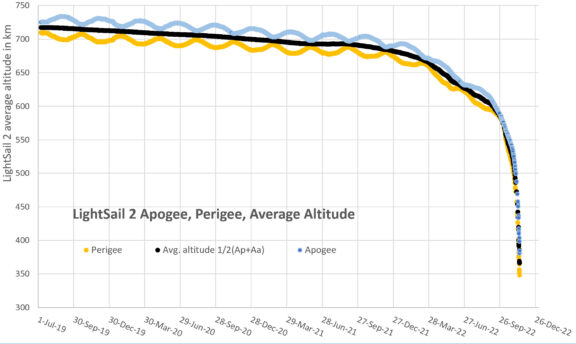The Planetary Society’s LightSail 2 mission reenters atmosphere, completes mission
For Immediate Release
November 17, 2022
Contact
Danielle Gunn
Email: [email protected]
Phone: +1-626-793-5100
Pasadena, CA (November 17, 2022) — LightSail 2, The Planetary Society’s crowdfunded, solar sailing spacecraft, has reentered Earth’s atmosphere, successfully completing its mission to demonstrate flight by light for small spacecraft. Orbital predictions showed that LightSail 2 reentered sometime on Nov. 17.
The reentry completes a mission of nearly three-and-a-half years, during which LightSail 2 showed that it could change its orbit using the gentle push of sunlight, a technique known as solar sailing. LightSail 2 demonstrated that small spacecraft can carry, deploy, and utilize relatively large solar sails for propulsion.
“LightSail 2 is gone after more than three glorious years in the sky, blazing a trail of lift with light, and proving that we could defy gravity by tacking a sail in space,” said Bill Nye, CEO of The Planetary Society. “The mission was funded by tens of thousands of Planetary Society members, who want to advance space technology.”
LightSail 2 hitched a ride to space in June 2019 aboard a SpaceX Falcon Heavy rocket. It began operations at an altitude of about 720 kilometers (450 miles), where Earth’s atmosphere is still thick enough to create drag and slow down a spacecraft. For reference, the International Space Station orbits at an altitude of roughly 400 kilometers (250 miles).
As atmospheric drag slowly pulled LightSail 2 back towards Earth, the spacecraft successfully used solar sailing to lower its decay rate and on occasion overcome drag completely. After 18,000 orbits and 8 million kilometers (5 million miles) traveled, drag finally won out, bringing the mission to a close.
“During its extended mission LightSail 2 continued to teach us more about solar sailing and achieved its most effective solar sailing, but that was followed by an increase in atmospheric drag in part from increasing solar activity,” said Bruce Betts, LightSail program manager and chief scientist for The Planetary Society. “The spacecraft is gone, but data analyses and sharing of results will continue.”
LightSail 2 launched as a shoebox-sized spacecraft with its sails tucked together like origami. Using four tape measure-like booms, the spacecraft unfurled a four-section Mylar sail with an area of 32 square meters (244 square feet) — about the size of a boxing ring.
Light has no mass, but it has momentum that can be transferred to a reflective solar sail. The resulting push is small but continuous, allowing a spacecraft like LightSail 2 to change its orbit.
The LightSail mission team will continue to analyze data collected during the mission, publishing peer-reviewed journal articles, making conference presentations, and conducting public outreach. Images from the mission can be viewed online.
Results will continue to be shared with other upcoming solar sail missions such as NEA Scout and ACS3. In a fitting bookend to the LightSail 2 mission, NEA Scout launched on Nov. 16 aboard NASA’s Artemis I mission to the Moon. The Planetary Society shares data with the NEA Scout team through a Space Act Agreement.
NEA Scout will use an 86-square-meter (926 square-feet) solar sail to leave lunar orbit and perform a slow flyby of asteroid 2020 GE, which measures just 18 meters (60 feet) across. The images NEA Scout captures will be the first up-close pictures of such a small world.
LightSail 2 was an entirely crowdfunded mission that aimed to help democratize space exploration. More 50,000 Planetary Society members, Kickstarter backers, private citizens, foundations, and corporate partners funded the mission. A miniature DVD attached to the spacecraft contained selfies from space fans and the names of Planetary Society members and supporters.
The Smithsonian Institution displayed two models of LightSail 2 in 2021 and 2022. The mission was named one of TIME’s 100 Best Inventions of 2019, and won a Popular Science Best of What’s New award for 2019.
The LightSail program’s roots date back to the mid-1970s, when Planetary Society co-founder Louis Friedman developed a NASA concept for a solar sail that would have visited Halley’s Comet. Society co-founder Carl Sagan showed off a model of the spacecraft on The Tonight Show with Johnny Carson.
While LightSail 2 operations have come to an end, the mission will live on as a new era of solar sailing begins.
“We have braved the harbor of Earth and found that a small craft can sail and steer,” said Betts. “Best wishes to those who sail similar craft into the vast ocean of space – we look forward to an exciting future of exploration, proud that we have played a role. Sail on!”
Press resources
Interviews with Planetary Society leaders are available upon request. Please coordinate with Danielle Gunn, chief communications officer, at [email protected]
Fans of the mission are encouraged to share their reflections using #ThankYouLightSail.
Images







Video
LightSail 2's views of Earth A compilation of images taken by The Planetary Society's LightSail 2 spacecraft from orbit. It shows the solar sails' deployment as well as many views of Earth.Video: The Planetary Society
Sailing the Light Sailing the Light tells the story of the LightSail mission, a crowdfunded space science project from The Planetary Society.Video: The Planetary Society
LightSail 2 Animation This animation details the piece by piece construction of the LightSail 2 spacecraft as well as its maneuvers in space.
About The Planetary Society
With a global community of more than 2 million space enthusiasts, The Planetary Society is the world’s largest and most influential space advocacy organization. Founded in 1980 by Carl Sagan, Bruce Murray, and Louis Friedman and today led by CEO Bill Nye, we empower the public to take a meaningful role in advancing space exploration through advocacy, education outreach, scientific innovation, and global collaboration. Together with our members and supporters, we’re on a mission to explore worlds, find life off Earth, and protect our planet from dangerous asteroids. To learn more, visit www.planetary.org.
###


 Explore Worlds
Explore Worlds Find Life
Find Life Defend Earth
Defend Earth

